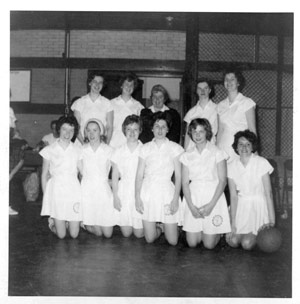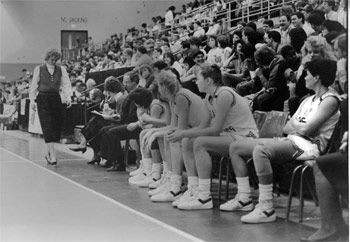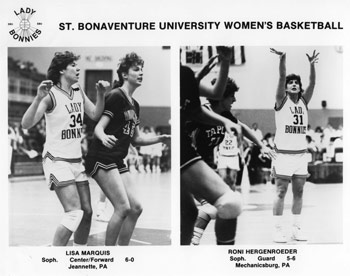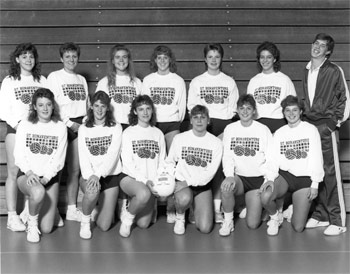
1974-1975 Women's Basketball team.
Title IX and SBU Women
1976 Evaluation Gender Equity Plan Gender Equity, 2004 NCAA vs. Smith
Title IX Background:
- For more information on Title IX click here.
- For a online copy of "Title IX: 25 Years of
Progress," click here.
SBU Title IX
Self-Evaluation, June 1,
1976
The University underwent a
self-evaluation in 1976, below are excerpts from the chapters of the evaluation.

1974-1975 Women's Basketball team.
Chapter I- Office of Admissions:
- Staff of 6 full-time workers; three female ( 2 secretaries,
1 Assistant Director of Admissions).
- Staff of 6 part-time student workers, all female.
- Recruitment: Individual secondary schools- 159 public or
private co-ed schools, 13 private male schools, 18
private female schools.
- "At present, no priority is given to whether the
candidate is male or female. Before 1971, female resident
students were limited due to available dormitory
space. Presently, however, the percentage of acceptable
candidates (54% male and 46% female) is closely proportionate
to the percentage of resident spaces available
(52% male and 47.6% female).
- Institutional aid: "...all allocations to prospective
candidates and upperclass persons are made on the basis
of both the financial resources of the student and
his/her family and the student's scholastic achievement."
Chapter II- Athletic Department:
- Men's intercollegiate program: 9 varsity sports (baseball,
basketball, swimming, soccer, golf, tennis, track,
rifle, cross-country) with about 160 men. Junior
varsity soccer and basketball were also available.
- Women's intercollegiate program: 5 varsity sports
(Basketball, swimming, field hockey, volleyball, tennis)
with about 82 women. No junior varsity programs
were available.
- Intramurals: 22 sports for men; 5 for women.
"Selection of sports or deletion of sports in both programs is
determined by demonstrated interest and
participation."
- Men out number women 2:1, therefore offerings are ok with
respect to undergrad enrollment ratios.
- "It should be noted that equal expenditure is not
required under the law, but that equal opportunity is a
desire outcome."
- Table of costs for Male versus Female equipment supplies
cost:
| Male | Female | |
| Tennis | $ 300 | $ 200 |
| Swimming | 700 | 540 |
| Basketball | 3,000 | 230 |
| Volleyball | -- | 240 |
| Field Hockey | -- | 300 |
| Soccer | 2,000 | -- |
| Track | 400 | -- |
| Cross-country | 560 | -- |
| Baseball | 1,190 | -- |
| Rifle | -- | -- |
| Golf | 250 | -- |
| Intramurals | 3,000 | 450 |
| Medical Supplies | 1,800 | 700 |
| $ 13,200 total | $ 2,660 total |
- Women's teams will be getting new, better uniforms in the 1976-77 academic
year.
- The University is working to get better practice equipment for Women as Title
IX deadline
draws near.

A 1963 Women's Basketball Club team photo.
Chapter III - Financial Aid Office:
- Three of three staff members are female.
- "In selecting needy students to receive financial
assistance, the University shall place primary emphasis upon
their character, future
promise, and academic achievement."
Chapter IV - Offices of Student Development:
- "Students may live off campus if they are 21 years of
age."
- Bonaville, a "mobile home complex will be restricted
to men in September 1976, but this is regarded as a
temporary measure. The
Housing Office projects that by September 1977 women will again be assigned to
Bonaville."
- Women's Dorms: Falconio, Loughlen, Floors in Francis and
Devereux
- Men's Dorms: Robinson and Shay, Floors in Francis and
Devereux
- More men have elected to live on campus than women,
therefore, the University will offer University property
on Union Street to 22 senior men to
help ease the housing problem.
- September, 1976: improvements to Devereux Hall include
fixing bathrooms on women occupied floors.
- A survey was sent to all University clubs to determine any
sexual biases. Out of 30 clubs, 27 returned the
surveys.
- Women's Council's response: "Since Title IX's main purpose is to
eliminate sex discrimination and the
basis for Title IX can be found in ending discrimination against women, the one
student organization
on the St. Bonaventure campus, which, ironically, will be hurt the most is the
Women's Council."
- Suggestions were given to the Women's Council on how to solve this problem;
including filing a 501a
tax exemption form and changing the Council's name to Greek but leaving
membership open to any
female student without requiring a pledge.
SBU Archives. Title IX 1976- Athletics, 12-110-377
Gender Equity Plan
Purpose:
- "...providing equitable intercollegiate programs for
male and female student-athletes...utilizing the Achieving
Gender Equity Manuel
distributed by the NCAA...established a plan...to ensure equitable treatment of
all
students participating in intercollegiate
athletics."
Intended Results:
- "...establish gender equity as a paramount
institutional objective. Regular monitoring and oversight will be
undertaken by the Director of
Athletics, Associate Athletic Director/SWA and Compliance, who also serves
as the department's Title IX
officer, and the University Athletics Committee (UAC)."
Equity 2000: General
- "Beginning with the 1992-93 academic year, the
Department of Athletics introduced a plan for addressing
gender equity concerns.
The original plan covered a five year period..., the plan has been extended
through
the 1999-2000 academic
year. Below are listed the yearly gender equity steps the Department of
Athletics
has undertaken."
1992-93:
- "Men's and women's basketball scholarship budgets
adjusted to represent identical financial aid allocations;
- Senior Women's Administrator hired;
- Practice time and facility usage allocated on an equitable
basis;
- Sports information staff travel with both men's and women's
basketball; and
- Administrative travel provided for both men's and women's
basketball."
1993-94:
- "Sports sponsorship adjusted to provide seven varsity
sports for men and seven varsity sports for women;
- Overall men's and women's scholarship allocations
identical;
- All operating budgets exceptions men's and women's
basketball are adjusted to provide identical amounts to
men's and women's sports;
- Secretarial support for men's and women's basketball
allocated equally. One full-time secretary to split work
day equally (e.g., morning with
men's basketball, afternoons with women's basketball)"
1994-95:
- "Survey of interests and abilities of undergraduate
student population undertaken;
- Women's soccer, volleyball and softball offices relocated
and upgraded"
1995-96:
- "Courtesy car program adjusted to provide equal
distribution of automobiles to men's and women's
basketball staffs (e.g., three cars
to each program);
- Head women's soccer coach position upgraded to full-time;
and
- Equal number of sports for men and women with full-time
coaches
1996-97:
- "Media guides for all sports provided on an equal
basis; and
- Schedule cards and posters for all sports identical.
- Departmental Gender Equity coordinator duties assigned
- Women's softball dugouts constructed"
1997-98:
- "Women's basketball operating budget adjusted to
compare with men's basketball operating budget; and
- Salary adjustments for women's basketball coaches"
1998-99:
- "Survey of interests and abilities of undergraduate students
to be completed."
Publicity:
- Mascot at equal numbers of men's and women's contests
- Cheerleaders perform at men's and women's basketball games
- Newspaper, radio, and television coverage of men's and
women's sports is regularly solicited
- Publications: Press releases, publicity initiatives and
other written materials are comparable for all sports.
Participation Rates:
- General: "During the 1993-94 academic year, St.
Bonaventure University adjusted the sports sponsored at the
intercollegiate level.
Since that time, intercollegiate sports participation has been comparable to the
distribution of male and female
general student body populations."
- Undergraduate enrollment distributions, 1994-95 and 1995-96
| 1994-95 | Gender | 1995-96 | Gender | ||||
| Men | 870 | 49% | Men | 857 | 50% | ||
| Women | 901 | 51% | Women | 846 | 50% | ||
| total | 1771 | total | 1703 |
- Numbers and percentages of student-athletes by sport:
|
1994-95 |
|||
| Men's Sports | Number of Participants | Women's Sports | Number of Participants |
| Baseball | 32 | Basketball | 14 |
| Basketball | 15 | Cross Country | 8 |
| Cross Country | 10 | Soccer | 23 |
| Golf | 9 | Softball | 18 |
| Soccer | 23 | Swimming and Diving | 18 |
| Swimming and Diving | 22 | Tennis | 9 |
| Tennis | 15 | Volleyball | 13 |
| total | 126 (56%) | total | 101 (44%) |
|
1995-96 |
|||
| Men's Sports | Number of Participants | Women's Sports | Number of Participants |
| Baseball | 33 | Basketball | 15 |
| Basketball | 14 | Cross Country | 15 |
| Cross Country | 11 | Soccer | 22 |
| Golf | 9 | Softball | 19 |
| Soccer | 19 | Swimming and Diving | 17 |
| Swimming and Diving | 23 | Tennis | 9 |
| Tennis | 11 | Volleyball | 16 |
| total | 120 (52%) | total | 113 (48%) |
Conclusions:
- "For the two year period after the adjustment in
sports sponsorship, the St. Bonaventure University
intercollegiate athletics
participation rates are substantially proportionate to the rules of enrollment
within
the general student
population. Utilizing the permissible variances from proportionality
specified in the
April, 1994, NCAA publication Achieving
Gender Equity, St. Bonaventure University is with in the 5
percentage point
variance."
Academic Support Services:
- "All academic support programming (e.g., access to Gus
Galasso Academic Support Center, tutors, access to
Academic Coordinator) is
provided equally to all student-athletes."
Athletics Financial Assistance:
|
Scholarships for 1995-96 |
|||
| Men's Sports | Women's Sports | ||
| Basketball | 13 full scholarships | Basketball | 14 full scholarships |
| Baseball | 9 tuition scholarships | Cross Country | 1 tuition scholarship |
| Cross Country | 1 tuition | Soccer | 8 tuition |
| Golf | 1 tuition | Softball | 6.3 tuition |
| Soccer | 8 tuition | Swimming and Diving | 1 tuition |
| Swimming and Diving | 11.3 tuition | Tennis | 3.44 tuition |
| Tennis | 3.44 tuition | Volleyball | 8 tuition |
Conclusions:
- "...the records demonstrated identical scholarship
budgets for men's and women's...programs"
Scheduling of Games and Practice Times:
- "For similar sports: all intercollegiate programs have
schedules that are basically equivalent." Deviations
are not more
than 1 contest more or less. "Evidence of preferential treatment in scheduling
of games and
practice
times is nonexistent."

1977
Housing and Dining Facilities and Services:
- "Student-athletes are treated in the same manner as the
general student population...All students utilize the same dining options, and the
University does not sponsor a 'training table.'"
Coaching:
- 14 sports total (Men: Basketball, Baseball, Cross Country,
Soccer, Swimming and Diving, Tennis, and Golf;
Women: Basketball, Cross Country,
Soccer, Swimming and Diving, Tennis, Softball, and Volleyball).
- Men's and Women's basketball have the NCAA maximum number
of coaches (1 Head Coach, 2 Full-time
Assistant Coaches, and 1 restricted
earnings coach).
- Six other sports have full-time coaches (Men: Soccer,
Swimming and Diving, Baseball; Women: Soccer,
Swimming and Diving, Volleyball).
- Men's and Women's tennis shares a coach.
- Part-time coaches include: Men's cross country and golf;
and Women's cross country and softball.
- Compensation and experience of Head Coaches:
| Men | Salary |
NCAA Div. I; Head or Assistant experience |
Women | Salary |
NCAA Div. I; Head or Assistant experience |
| Basketball | $90,000 | 16 years | Basketball | $40,000 | 5 years |
| Cross Country | $-- | 3 | Cross Country | $-- | 3 |
| Soccer | $25,000 | 8 | Soccer | $20,000 | 3 |
| Tennis | $11,250 | 4 | Tennis | $11,250 | 4 |
| Baseball | $21,000 | 13 | Volleyball | $22,500 | 6 |
| Golf | $1,750 | 4 | Softball | $5,000 | 4 |
| Swimming and Diving | $25,000 | 7 | Swimming and Diving | $27,250 | 8 |
- "In all sports other than men's and women's basketball, the experience and
compensation of
coaches is comparable."
- Conclusions: "The coaching opportunities for male and
female student-athletes are equivalent in almost every
sport. Men's and women's
basketball coaching positions show a significant disparity in experience and
salaries for the men's and women's
Head Coaches. The University has recognized this disparity, and has
outlined corrective action for the
future in the Equity 2000 plan.
Locker Rooms, Practice, and Competitive Facilities:
- "During the summer of 1997, and exclusive women's
basketball locker room will be constructed. The locker
room that is currently shared with
women's soccer will become a women's soccer and softball locker room."
- "All practice and competitive facilities are
comparable with the exception of the softball field. Dugouts are
scheduled in the Equity 2000
plan..."
- "Only minor discrepancies exist, and a schedule to
address the needs is in place. Complete compliance in this
area will be realized within the next
24 months."
Medical and Training Facilities and Services:
- "...provide all student-athletes, male and female,
scholarship or walk-on, starter or reserve, the highest level of
medical and training support
possible."
- "The weight room and training room services [are open
to] all student-athletes, no priority system is in place...
and both men's and women's basketball
have priority use in the weight room."
- Conclusions: "Pre-game operations in this area are
identical for all student-athletes."
Travel and Per Diem:
- "The modes of transportation for all sports other than
men's and women's basketball are typically vans from
the university motor pool...men's
basketball travels more frequently by airplane than women's basketball for
similar trips. This discrepancy
is addressed under the Equity 2000 section, and equitable travel and per
diem allowances are projected."
- Conclusions: "This institution has a plan for achieving
equity in this area."
Recruitment of Student-Athletes:
- "All teams are provided an allocation of complimentary
rooms for recruiting at a local hotel. Room
allocations are:
| Men's Sport | Number of Rooms | Women's Sport | Number of Rooms |
| Basketball |
7 |
Basketball | 7 |
| Soccer | 7 | Soccer | 7 |
| Swimming and Diving | 7 | Swimming and Diving | 7 |
| Tennis | 3 | Tennis | 3 |
| Baseball | 6 | Softball | 6 |
| Cross Country | 1 | Cross Country | 1 |
| Golf | 2 | Volleyball | 6 |
|
total |
33 |
total |
37 |
- "Only two (2) sports, men's and
women's basketball, have access to courtesy automobiles. Both programs
have three (3) automobiles
available."
- "Men's basketball and women's basketball recruiting
budgets have not compared favorable. The
institutional equity plan addresses
this disparity, and projects compliance."
- Conclusion: "With the plan to address recruiting
funding deficiencies for women's basketball in place, this
area has been satisfactorily
addressed."

1988
SBU Archives, Athletics- Gender Equity Plan, 12-110-325
Gender Equity Report, August
2004
Athletic Financial Assistance:
- For 2002-2003 the "University awarded 37.27
scholarship equivalencies to male student-athletes and
38.34
female student-athletes. In
sheer numbers, 82 male student-athletes representing an expenditure of $875,736,
received athletically-related student
aid, as compared to 95 female student-athletes, with an expenditure of
$897,673."
- "...Men's basketball is the only sport funded at the
NCAA maximum limit. Women's basketball, along with all
of our non-revenue sports, does not
award scholarships at the NCAA maximum number allowed."
- "Still the University is meeting the goal of achieving
gender equity as it relates to participants, dollars
committed, and scholarships
awarded...at this time, we are pleased with our progress in this area."
Accommodation of Interests and Abilities:
- From a survey of sample students, spring 2004:
- "Given your own personal
interest, are you satisfied by the current intercollegiate sports offerings?"
- A 6-1 margin answered yes.
- "Almost half of those surveyed
answered positively to the question, 'Are there any sports not currently
offered by
St. Bonaventure University at the intercollegiate level that you believe should
be offered?'"
- The most requested sport was
women's volleyball, the second was football.
Equipment and Supplies:
- Some coaches are upset with the budget allotments.
- For the 2002-2003 season $59,243 was budgeted to men's
teams while $49,400 was budgeted to women's teams.
- The reason stated for this difference were the financial
hardships of the 1990s, which made for little funding in
the early 2000s.
Scheduling of Games and Practice Times:
- Nine teams total need to use the Reilly Center (RC),
however men's and women's basketball have priority over
the the non-revenue sports when they
are in season.
- Improvements to the RC must be made; a list of general
improvements:
-
"An outdoor tennis facility for men's and women's tennis teams"
- "An indoor practice facility for several sports."
- "An artificial turf field, primarily for women's lacrosse, but also to be
utilized by baseball, softball, and
soccer teams."
- Additional locker room space is
also needed for visiting teams, whose locker room space is currently,
"barely adequate".
- "Locker room facilities of the non-revenue sports
teams must be upgraded."
Travel and Per Diem Allowance:
- "In academic year 2002-2003, the University spent
$314,517 on team travel and per diem for men's sports, and
$230,234 on women's sports. The
majority of money was spent on men's basketball ($168,792). This apparent
discrepancy is related primarily to
differences in schedules and the geographic distribution and number of
away games. In comparable
sports, budget expenditures were substantially equitable, once factors such as
geographic distribution and number of
away games and sizes of squads are taken into consideration."
Coaching:
- Discrepancies are present.
- "Overall, the University spends $603,401 on men's
sport program salaries and $300,082 on women's sport
program salaries (2002-2003
figures). Benefits for each are $110,914 (men) and $73,547 (women).
The majority
of the expenditures can be traced to
men's basketball coaches' salaries and benefits. Part of the inequality is
attributed to the costs of running a
Division I basketball program at the men's and women's level; part, too, is
attributable to the greater longevity
of coaches of men's and women's teams."
Publicity:
- "The majority of publicity efforts are focused on
men's basketball and women's basketball."
Recruitment of Student-Athletes:
- Is "dominated by men's and women's basketball.
- 2002-2003 men's basketball budget was $24,292 out of a
total budget for men's sports of $32,045.
- 2002-2003 women's basketball budget was $26,200 out of a
total budget for women's sports of $32,651.
Findings/ Plans of Corrective Action:
- Survey of coaches concerning gender equality status had
a 100% response rate.
- "Overall, the survey...showed our program to be
gender-equitable...such as number of scholarships, access to
playing and practice facilities...but
we - and the coaches - did note three specific areas of gender inequality.
Those areas are: coaches salaries,
secretarial support and locker room facilities."
Analysis of three areas for improvement:
Coaches Salaries:
- "Situation as it exists now: the most
glaring discrepancy" is salaries for the heads of men's and women's
basketball along with assistant
coaches.
- "Historical perspective: Men's
basketball has always been the marquee program at St. Bonaventure University,
both in terms of revenue and
attendance. Women's basketball was swept into Division I as a result of
NCAA
regulations and, though it continues
to climb in prestige, has not yet reached the level of the men's program."
- Recent coaching changes on both sides has made the problem
better and worse.
- "Plan of corrective action: The Director
of Athletics presented an educational informational session to the Board
of Trustees in a June 2004
meeting."
- The Department hopes to use, "contributions so that we
can then use those funds to level the fiscal playing
field between the two programs."
- Title Responsible: Director of Athletics; Development
Officer for Athletics
- Projected time frame: "To be within 25% of
compatibility by the year 2007."
Secretarial Support Services:
-Situation as it exists now: Men's basketball has
a secretary while women's basketball has none.
- Historical perspective: The two teams used to share
a secretary, changes occurred over time and women's
basketball opted not to have a
secretary and divert those funds. However, the team would now like a
secretary.
- Plan of corrective action: "Because of
shifting priorities and realignment within the University structure, we
anticipate this situation to be
addressed without any budgetary impact."
- Title of Position Responsible: Director of Athletics;
Senior Associate Athletics Director; Associate Athletic
Director for Internal Operations;
Women's Basketball coach.
- Time frame: This is "dependent upon internal
University realignments, ...expect...by January 2005."
Locker Room Facilities:
- Situation as it exists now: The issue is the
quality of the men's basketball locker room and the women's
basketball locker room.
- Historical perspective: This was not the case four
years ago, when the women's locker room had an upgrade.
However, in 2001, the men's
basketball locker room got "revamped" and is now ahead of the
women's
locker room.
- Plan of corrective action: "We will be
seeking capital contributions for the upgrade of the women's basketball
locker room."
- Title of Position Responsible: Director of Athletics;
Development Officer for Athletics; Associate Athletic
Director for Internal Operations.
- Project time frame: Equitable by start of the 2006 season.
Conclusions:
- "While strides have been made in the area of
gender equity since our last report we acknowledge there needs
to be continued vigilance."

1989
SBU Archives- Gender Equity Plan 12-110-325
NCAA vs. Smith, February 23, 1999
A former St. Bonaventure student
was involved in Title IX court case that rose to the US Supreme Court.
Renee Smith was an SBU undergraduate, and had played volleyball for the
University from 1991-1993. Smith wanted to continue her eligibility at her
next two schools, however, the NCAA denied her request to play volleyball as a
graduate student at Hofstra University and the University of Pittsburgh.
According to the NCAA, graduate students can only play varsity sports at the
institution they attended as an undergraduate.
Smith then decided to sue under Title IX, because more men
had received waivers to play as graduate students at another university than
women had. The court dismissed her complaint and an appeal was issued.
The appeal was a success and the case was reinstated on the
point that the NCAA could be said to get Federal monetary assistance due to the
fact that member schools receive Federal support and the NCAA makes an income
from these member schools. The case then rose to the US Supreme Court,
where the ruling was in favor of the NCAA. Justice Ruth Bader Ginsburg
stated, "that entities receiving Federal assistance, whether directly or
indirectly through an intermediary, are recipients with in the meaning of Title
IX. But entities that simply benefit economically from Federal assistance
received by others are not."

1988 Women's Volleyball team.
06/21/2007